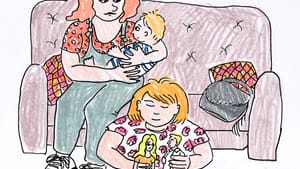Stay in the Loop
BSR publishes on a weekly schedule, with an email newsletter every Wednesday and Thursday morning. There’s no paywall, and subscribing is always free.
Girls’ work: Wage inequality starts early
‘The Cost of Being a Girl,’ by Yasemin Besen-Cassino

Montclair State University sociology professor Yasemin Besen-Cassino’s The Cost of Being a Girl explores the roots and effects of the gender pay gap: that roughly 20 cent-per-dollar distance between men’s and women’s earnings. What’s surprising is how early the wage gap starts and how much teenage work experiences affect adult careers.
By centering on girls and young women, Besen-Cassino filtered out factors that come into play in peak earning years, such as childbearing and household responsibilities. She also examined data including a long-term study of 9,000 workers aged 12 to 19, and conducted in-depth interviews with women aged 18 to 24.
Her conclusion? Girls encounter conditions and expectations in a range of jobs that disadvantage them and perpetuate traditional gender roles. These contradict the values of equality and gender neutrality they may encounter at home and in school.
Personal stories behind statistics
Though the book is academic in style, with research citations and statistics, its personal commentaries are interesting for general readers. Among the young college women Besen-Cassino interviewed was Kiara, 20, who worked 40 hours a week at two part-time jobs, ran track, and hoped to attend graduate school.
Emily, 21, had been a babysitter since age 12 and ultimately became a nanny, maid, and household manager for her clients. She organized children’s schedules, provided their transportation, ran the family errands, cleaned, did laundry, and cooked. Her hourly rate never increased.
The stories resoundingly demonstrate the inequality met by girls who work for the same reasons boys do: for money, socialization, and experience. The Cost of Being a Girl challenges the accepted wisdom that working benefits young people. Not always — especially if the young person happens to be female.

Babysitting: The better you are, the worse it gets
Besen-Cassino found boys and girls on equal footing in their earliest jobs, at age 12 or 13. Differences quickly emerged at 14 to 15, when boys tended to move from freelance jobs such as mowing lawns and shoveling snow to structured jobs in retail and services.
Girls stayed longer in the freelance market, with its poorly defined wage-task-time structure. Many babysat and found themselves caught in the trap of being emotionally tied to clients, feelings of loyalty leading them to take on almost unlimited functions without being offered — or asking for — more pay.
Interestingly, Besen-Cassino finds in this some justification for women’s reluctance to ask for raises. “At a young age, babysitters have firsthand experience of what happens when they ask for more money… Babysitters face being stereotyped whether they show care or treat their jobs with emotional distance. While emotional distance makes them look cool, aloof, and not nice, being emotionally involved traps them in another gendered stereotype… Research suggests that this experience… is mirrored by women and employers throughout the economy.”
Several of the 35 babysitters interviewed reported taking on additional children and responsibility without proportional pay increases. Some took classes in CPR and developmental psychology to enhance marketability. Others paid for treats without reimbursement. Many rearranged their schedules, even missing class to accommodate a sick child or snow day.
Female interviewees came prepared, bringing items to amuse children while they spoke with adults. Yet this preparation and skill was often dismissed with the comment that the young woman “was a natural.”
The few male babysitters Besen-Cassino interviewed felt no need to make an instant emotional connection or prepare so extensively. They did not expect, nor were they expected, to take on an open-ended portfolio of chores.

Retail: stylish servitude
Young people often gravitate to retail and service-sector jobs, and Besen-Cassino interviewed many young women working in those areas. Young women in retail “were more likely to be placed in positions to deal with difficult customers and more likely to mentor and help their male counterparts… [and] experienced differential levels of aesthetic labor requirements.”
In other words, employers told the young women how to look and sound. Plus, handling difficult customers was not viewed as a prestige assignment and prevented girls from doing managerial tasks or receiving training that would allow them to advance.
Retail employment often came with the expectation that employees buy and use a store’s products to embody an idealized brand image. Young women in these environments felt pressure to measure up, spending more than they earned on clothes, for example, and developing unhealthy body images. Workers often dieted and exercised to emulate the right “look.” Applicants from low-income, minority backgrounds who did not fit the aesthetic were less likely to be hired.
In looking at girls’ and young women’s first jobs, Besen-Cassino sheds new light not only on the gender wage gap but on how different the experience of work is for young women. She begins to uncover the long-term effects of girls and women fitting into an economy still built by and for independent men, and the costs of trying to accommodate the biases implicit in such a system.
“The pay gap does not start,” she writes, “when women are 30 or 40. It has roots in the work of children as young as 12, and if our society wants to eliminate the pay gap, it needs to understand how it begins.”
Hear Yasemin Besen-Cassino speak at Temple University’s Paley Library Ground Floor Lecture Hall (1210 W. Berks Street, Philadelphia) on Monday, October 15, 2018, at 2pm.
What, When, Where
The Cost of Being a Girl: Working Teens and the Origin of the Gender Wage Gap. By Dr. Yasemin Besen-Cassino. Philadelphia: Temple University Press, 2017. 208 pages, paperback; $27.95. Click here.
Sign up for our newsletter
All of the week's new articles, all in one place. Sign up for the free weekly BSR newsletters, and don't miss a conversation.

 Illustration by Hannah Kaplan
Illustration by Hannah Kaplan